India is a land of diverse cultures, traditions, and practices that have captivated the world’s attention for centuries. With a history spanning over several millennia, it’s no surprise that Indian culture has left a lasting impact on the world. From ancient temples to modern-day festivals, India’s traditions and practices are a testament to its rich past and vibrant present.
In this blog post, we will explore three of the most traditional practices that characterize Indian culture and have stood the test of time.
1. Yoga
Yoga is one of the most well-known Indian practices and is renowned worldwide for its numerous health benefits. It is believed to have originated in India over 5,000 years ago and has been passed down from one generation to the next. Yoga is an ancient practice that promotes physical, mental, and spiritual well-being. It consists of various postures, breathing exercises, and meditation techniques that help in relaxing the mind and body, improving concentration, and reducing stress levels.
Yoga has numerous benefits, both physiological and psychological. It helps improve flexibility, strength, and balance, in addition to reducing anxiety, depression, and insomnia. Moreover, yoga has been shown to improve heart health, lower blood pressure, and improve lung function.
2. Ayurveda
Ayurveda is an Indian traditional system of medicine that dates back to over 5,000 years. It is based on the belief that a balance between the mind, body, and spirit is essential for good health. Ayurveda aims to promote health, prevent illness and treat diseases using natural remedies, diet, and lifestyle modifications.
Ayurveda is a holistic approach to wellness that emphasizes the use of natural herbs, massage, aromatherapy, and yoga. It is widely recognized as an alternative to Western medicine and has been increasingly popular in recent years.
3. Classical Dance Forms
Indian classical dance forms are an integral part of the country’s culture and history. Dance is believed to have originated in India several thousand years ago and has since evolved into a complex and varied art form. There are several classical dance forms in India, each with its unique style, costumes, and music.
The most popular classical dance forms in India include Bharatanatyam, Kathakali, Kuchipudi, and Odissi. These dance forms have been recognized by UNESCO as part of the world’s intangible cultural heritage.
Conclusion
India is a country rich in culture and tradition, from arts to culinary skills to ethnic wear and dance forms. The three practices discussed in this blog post are examples of India’s thriving cultural heritage. They are also practices that are easy for anyone to learn and adopt, regardless of their cultural background. Yoga, Ayurveda, and classical dance forms are a testament to India’s contribution to the world and its ongoing pursuit of wellness, health, and artistic expression.
(Note: Do you have knowledge or insights to share? Unlock new opportunities and expand your reach by joining our authors team. Click Registration to join us and share your expertise with our readers.)
Speech tips:
Please note that any statements involving politics will not be approved.
